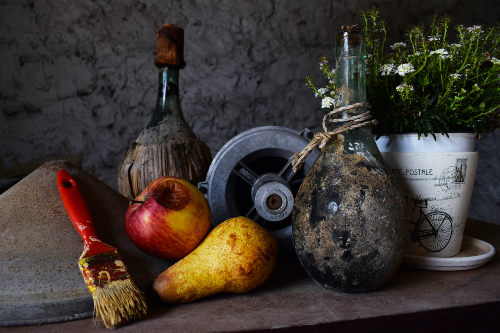You don't need a professional photo studio to photograph a still life. What you do need is a large dose of patience. In fact, you yourself are responsible for all the little details. The light, the decoration, the composition and so on. Since you, as the photographer, are responsible for everything in a still life, it is the ideal opportunity to practice telling a story.
What do you want to know about photographing still life?
What is a still life? | Tips | Placement and combinations | Composition | Construction | Light | Shutter speed
A still life is something many people know from classical art, but even in this day and age it is still something that is done a lot. A little less with a paintbrush and a little more with a camera. If you look the word up in a dictionary, it's simply explained: a composition of inanimate objects.
The composition can be in any form, think flowers, tableware, musical instruments or an average meal. If you don't want to capture the standard still life, look for your favourite objects to photograph.

Combine and place
Once you've figured out the main object for your still life, it's time for the fun but complicated work. What other objects do you choose, which objects form nice combinations and provide cohesion? Because remember, your still life is not supposed to look like a rug at the street market. No fragmented chaos! The idea is that your still life tells a story, or at least has a theme. Once you have a clear idea of your story and theme, you can get to work placing the objects.
Getting started composing
You're not there yet with just deciding on the objects of the still life. The background and surface are of as much importance as the objects. Look for a surface that matches the mood you want to exude. For example, choose a tablecloth or just a sturdy shelf. Do exactly the same with the background and make a nice combination.
Construction
Time to go to the drawing board and think about the ideal composition. How do you want to set everything up, what fits well together but, most importantly, what tells the story you want to convey? Make an outline of the ideal composition, grab your camera and put it on a tripod. Look at your sketch and through the viewfinder at regular intervals to see if you have succeed in creating the image you envisioned.
Light
Now that you have everything installed in the right place, the next step is to look at the light. Normally, you might choose to use daylight, but for a still life, the use of softboxes and flash umbrellas is recommended. Why? Simply because you have the freedom to arrange the light the way you envision it. After all, light turns that fine picture into a work of art.
Shutter speed
When you get started using artificial lighting, it is all the more important to keep a close eye on your settings. Shutter speed, in particular, is very important for proper exposure in your photos. By setting the shutter speed correctly, you ensure that your still life will be clearly visible in the photo. By playing with the shutter speed, you can see whether the artificial lighting is ideal or if it needs correcting. Want to make your photo darker or lighter? Use the shutter speed or the exposure triangle untill you're happy with the results. In addition to the amount of light in the photo, the shutter speed also determines the amount of motion blur. A faster shutter speed means you take a picture faster which means there is less motion blur. Want to make sure your still life is properly exposed without any motion blur? If so, always choose to work with a tripod. Better safe than sorry!

Read more